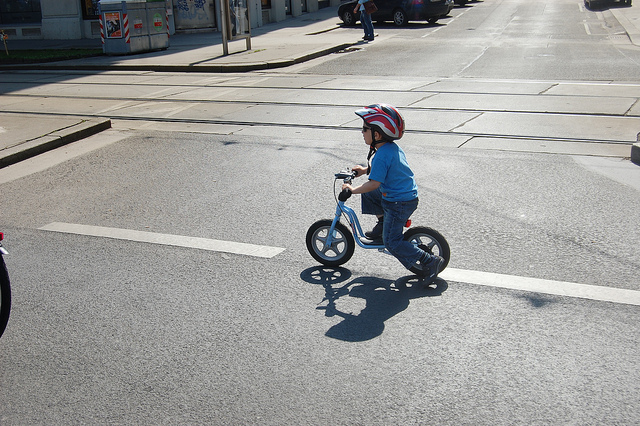
What Age Should Children Start Cycling? Live Coverage from Velo-city
What is it that makes children and cycling so special? ECF policy officer, Fabian Kuster, shares his own personal experiences with some insight he’s picked up from Velo-city in Vancouver.
I’m here at at the Velo-city conference, and talk about ‘Children and cycling” is everywhere. This topic connects people because the joy of learning to ride a bicycle is a universal one, and it’s hard not to remember the first time we all learnt to ride a bicycle.
I absolutely loved Gil Penalosa's opening speech at the conference. One of my favourite quotes was when he said, "we have to stop designing cities for athletic 30 year olds." And he's spot on. We have to start designing cities, and traffic, for children. That's when we know we've got it right. If our own children can get on two wheels.
I’ve never been one to remember much of my childhood, but my first bike ride will always be with me. That lasting feeling of joy and pride, also of liberation as I could travel faster and further. If I was to step into the shoes of my doctor, he would have told me that it was good for my physical and cognitive development. And so, my childhood love for cycling became a life-long habit: I am a daily cyclist to this very day.
Today, being a father myself, I ask myself the same question that many parents ask: Will I let my my children cycle by themselves in traffic? And if so, what’s the right age?
The Bigger Picture
Taking a step back, we see many different levels of cycling to school in various countries. While it is very low in the English-speaking world, about half of the primary schoolchildren in the Netherlands cycle to school.[i] But there are also worrying signs outside the English speaking world: In Switzerland cycling to school among 6 – 14 year olds has decreased by almost 20% between 1994-2005.[ii]
Why? From what I’ve learned at Velo-city, today’s parents have numerous safety concerns, both traffic danger and stranger danger. But the reality is that the real danger has not increased over the past decade in most places in the developed world, quite to the contrary. What has changed is the media attention given to it and our changed perceptions. Addressing these concerns seems to be crucial if we are to get more children on their bikes.
Many good projects have been developed in the past, including “Safe routes to school” by Sustrans and ‘Bikeability’, a good practice cycle training programme that encourages and inspires children to cycle, by ‘Cycling England’, to name but a few.
When ‘Cycling England’ started the Cycling Demonstration Towns programme in 2005, selected cities had to make choices on which target groups they should focus on. The first target group identified was young people aged 8 – 14. At the time, less than 1% of British children cycled to school, despite the fact that nearly half said they wanted to.[iii]
‘Bikeability’ has been a major success by training more than 250,000 children over the last few years. In the Netherlands, where the majority of students cycles to school, ECF member Fietsersbond has produced a check list with 25 actions that schools and local authorities should implement in ensuring and encourage safe cycling to school.[iv] Are the routes to school safe for cycling? Is there sufficient and easily accessible bike parking at school? Do parents and teachers set a good example?
Talking about setting the good example. I was speaking to somebody at the conference who told me about a case study from Davis, California. A study here showed that 34 % of children cycled to their weekend soccer practice in households where parents were daily cyclists, compared to only 2 % where parents never cycled.[v]
And getting kids onto bikes and out of cars isn’t just good for the kids themselves. In most European cities, about a quarter of car traffic during morning rush hours is caused by parents driving their kids to school. So by driving our “little darlings” to school, we’re unconsciously adding to congestion, air pollution, noise...and, ironically, to the unsafe road conditions that parents want to protect their children from in the first place. That’s without even mentioning that today’s kids are getting fatter.

Credit: carpediembecky.blogspot.com
Another issue that matters is distance. The shorter the distance, the more walking and cycling. This means that city planners need to rethink they way they approach urban planning. Again, in Davies, among children living within 800 metres of the soccer field, 60 % of children cycled to soccer practice; for children living 2.4 – 6.4 km from the soccer field, this figure fell to approximately 10 %.
With the ‘Charter of Vancouver’, to be signed at the end of the week at Velo-city, ECF will be bringing the issue to the United Nations. If the world’s leaders get behind this movement, let’s hope that they can start building cities that are more children friendly.
And let’s hope that in a decade time, parents won’t have to ask the question: “Should I let my children cycle alone?” but rather “how much should I spend on their first bicycle?"
Time to design our cities for children.
 About the Author
About the Author
Fabian Küster is a Senior Policy Officer at the European Cyclists’ Federation and is regularly following EU developments and legislation, liaising with key stakeholders. He has previously worked in Brussels for a German Member of European Parliament and the German Embassy. He has a wealth of experience in and around the EU institutions, and is an expert in the EU policy field of bicycles
Live Coverage from Velo-city
ECF is reporting this story live fom the world’s largest cycling policy in Vancouver, Canada where nearly 1,000 of the cycling world’s best and brightest have gathered for four days to talk cycling. You can read more stories from our Velo-city live page and tweet #velocity2012 to join in the conversation.
References
Contact the author
Recent news!
Upcoming events
Contact Us
Avenue des Arts, 7-8
Postal address: Rue de la Charité, 22
1210 Brussels, Belgium










